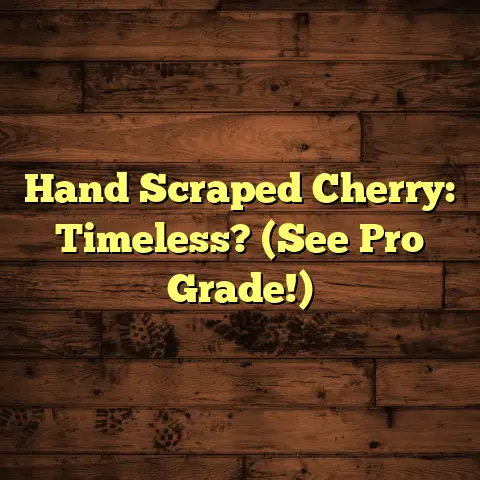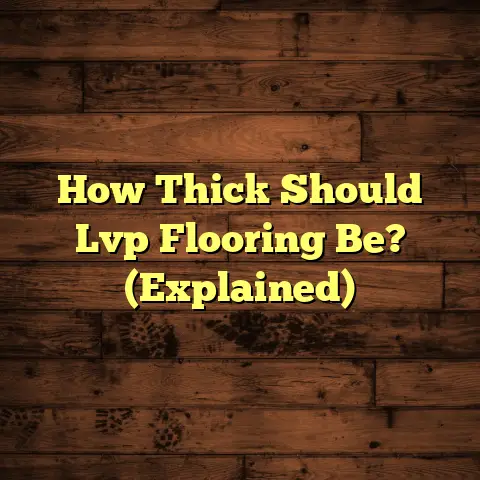Water Stains on Hardwood? (3 Fixes or Replace!)
Ever walked into your living room, ready to relax, and BAM!
Your eyes lock onto an ugly water stain marring your gorgeous hardwood floor?
Ugh, I know the feeling.
It’s like a little slap in the face from your house, whispering tales of forgotten spills, sneaky leaks, or even a “gift” from your furry friend.
What if I told you those stains aren’t just unsightly blemishes?
They could be a sign of deeper problems.
In this article, I’m pulling back the curtain on those stubborn water stains.
We’ll weigh the cost of fixing them against the possibility of a full-blown floor replacement.
I’ll walk you through three effective fixes that might just breathe new life into your hardwood floors.
Or, we’ll figure out if it’s time to consider a more drastic change.
Let’s dive in!
Section 1: Understanding Water Stains on Hardwood Floors
Alright, let’s get down to brass tacks. Water stains aren’t all created equal.
Think of them like different levels in a video game – each requiring a unique strategy to conquer.
Types of Water Stains:
Surface Stains: These are the easiest to deal with.
They’re usually caused by recent spills that haven’t penetrated too deeply.
Think of a spilled glass of wine or a wet umbrella left by the door.Deep Stains: These are the tougher customers.
They’ve soaked into the wood fibers, often caused by prolonged exposure to moisture, like a leaky pipe or a pet accident that went unnoticed.
Causes of Water Stains:
Spills: Obvious, right?
But it’s not just about what you spill, but how quickly you clean it up.Leaks: These are the sneaky culprits.
A slow, dripping faucet, a hidden pipe leak, or even condensation can cause serious damage over time.-
Humidity: Ever notice how your floors creak more in the winter?
That’s because wood expands and contracts with changes in humidity.
Excessive humidity can lead to moisture absorption and, you guessed it, water stains.
Pet Accidents: Let’s be honest, accidents happen.
But pet urine is particularly damaging because it’s acidic and can penetrate deeply into the wood.
How Moisture Interacts with Hardwood:
Wood is a natural material, which means it’s porous.
Think of it like a sponge – it absorbs moisture.
When wood gets wet, it expands.
When it dries, it contracts.
The Impact of Climate and Seasonal Changes:
I live in Michigan, where we experience extreme seasonal changes.
One day it’s sunny and 75°F, the next we are back to 40°F and raining sideways.
This affects the wood floors in homes.
In the summer, high humidity can cause wood to swell.
In the winter, dry air can cause it to shrink.
These changes can exacerbate existing water stains and even create new ones.
Relatable Scenarios:
-
The Holiday Spill: Picture this: It’s Thanksgiving, the family’s gathered, and little Timmy spills his cranberry juice all over the floor.
Panic ensues, but the stain seems minimal at first.
A week later, you notice a faint discoloration.
That’s a surface stain that could have been prevented with quick action.
-
The Sneaky Leak: You’ve been noticing a musty smell in your basement for a while, but you can’t quite put your finger on it.
One day, you discover a small leak under your washing machine.
The water has been seeping into the hardwood floor, creating a dark, deep stain.
This is a more serious issue that requires immediate attention.
Section 2: Assessing the Damage
Okay, so you’ve got a water stain.
Now what?
Before you start grabbing cleaning supplies or calling a contractor, it’s crucial to assess the damage.
This will help you determine the best course of action.
Visual Indicators of Damage:
Discoloration: This is the most obvious sign.
Look for dark spots, rings, or a general change in the wood’s color.-
Warping: If the wood is uneven or buckling, it’s likely absorbed a significant amount of moisture.
Mold Growth: This is a serious issue.
Mold can grow in damp environments and can be harmful to your health.Look for fuzzy, greenish-black spots.
-
Cracking: This indicates that the wood has dried out and contracted, often after being exposed to excessive moisture.
Determining the Stain’s Depth:
-
Surface Stains: These stains are usually light in color and don’t penetrate too deeply into the wood.
You should be able to see the wood grain through the stain.
-
Deep Stains: These stains are darker and more pronounced.
They may obscure the wood grain and can even cause the wood to feel soft or spongy.
Tips for Assessing the Damage:
Use Your Senses: Look, touch, and even smell the affected area.
Does it feel damp?
Does it have a musty odor?-
Shine a Light: Use a flashlight to examine the stain at different angles.
This can help you see the depth and extent of the damage.
-
Test a Small Area: Before applying any cleaning solutions, test them on an inconspicuous area to make sure they don’t damage the finish.
-
Call a Professional: If you’re unsure about the extent of the damage, don’t hesitate to call a professional flooring contractor.
We have the tools and expertise to accurately assess the situation and recommend the best solution.
Section 3: The Cost of Replacement vs. Repair
Alright, let’s talk money.
One of the biggest questions homeowners face when dealing with water-damaged hardwood is: “Do I repair or replace?”
The answer depends on several factors, including the extent of the damage, the type of wood, and your budget.
Cost Analysis:
-
Repairing Water-Damaged Hardwood: This can range from a few dollars for DIY solutions to several hundred dollars for professional refinishing.
-
Replacing the Entire Floor: This is the most expensive option, ranging from several thousand dollars to tens of thousands, depending on the size of the area and the type of wood you choose.
Factors Influencing the Decision:
-
Type of Wood: Some woods are more resistant to water damage than others.
For example, hardwoods like oak and maple are more durable than softwoods like pine.
-
Size of the Affected Area: If the water damage is limited to a small area, repair may be the more cost-effective option.
However, if the damage is widespread, replacement may be necessary.
-
Labor Costs: Professional refinishing and replacement can be expensive, depending on the contractor you choose and the complexity of the job.
Real-Life Case Studies:
-
The Homeowner Who Chose Repair: I once worked with a homeowner who had a small water stain under their refrigerator.
We were able to repair the stain by sanding down the affected area and applying a new coat of finish.
The total cost was around \$300, which was significantly less than the cost of replacing the entire kitchen floor.
-
The Homeowner Who Chose Replacement: I also worked with a homeowner who had extensive water damage throughout their entire living room.
The damage was so severe that the wood was warped and moldy.
In this case, replacement was the only viable option.
The total cost was around \$10,000, but the homeowner was thrilled with the results.
They now have a beautiful, new hardwood floor that will last for years to come.
Here’s a quick cost comparison table:
Note: These costs are estimates and can vary based on location, the type of wood, and the contractor you choose.
The best way to determine whether to repair or replace your water-damaged hardwood is to consult with a professional flooring contractor.
We can assess the damage, provide you with a detailed estimate, and help you make the best decision for your home and budget.
Section 4: Fix #1 – DIY Solutions for Surface Water Stains
Alright, let’s get our hands dirty!
If you’ve determined that you’re dealing with a surface water stain, you might be able to fix it yourself using common household items.
DIY Methods:
-
Vinegar and Olive Oil: This is a classic remedy for removing water stains from wood furniture and floors.
Mix equal parts vinegar and olive oil in a spray bottle.
Spray the mixture onto the stain and let it sit for a few minutes.
Then, wipe it away with a clean cloth.
The vinegar helps to dissolve the stain, while the olive oil helps to moisturize the wood.
-
Baking Soda Paste: This is another effective DIY solution.
Mix baking soda with water to create a thick paste.
Apply the paste to the stain and let it sit for several hours or overnight.
Then, wipe it away with a damp cloth.
The baking soda acts as a mild abrasive, helping to lift the stain from the wood.
-
Hair Dryer: This method works best for fresh water stains.
Set your hair dryer to the lowest setting and aim it at the stain.
Move the hair dryer back and forth over the stain until it disappears.
The heat from the hair dryer helps to evaporate the moisture from the wood.
Step-by-Step Instructions:
-
Clean the Area: Before applying any DIY solutions, make sure to clean the area thoroughly.
Remove any dirt, dust, or debris.
-
Apply the Solution: Apply the DIY solution to the stain, following the instructions above.
-
Let it Sit: Allow the solution to sit on the stain for the recommended amount of time.
-
Wipe it Away: Wipe away the solution with a clean cloth.
-
Repeat if Necessary: If the stain doesn’t disappear completely, repeat the process.
Before-and-After Visuals:
Unfortunately, I can’t include actual visuals in this text-based format.
However, I can describe what you might expect to see:
-
Before: A light-colored ring or spot on the wood surface.
-
After: The ring or spot is significantly lighter or completely gone.
The wood looks more uniform in color.
Important Note: Always test any DIY solution on an inconspicuous area of your floor before applying it to the stain.
This will help you make sure that the solution doesn’t damage the finish.
Section 5: Fix #2 – Professional Refinishing
Sometimes, DIY solutions just aren’t enough.
If you’re dealing with a more stubborn water stain, or if you want to restore your entire floor to its original glory, professional refinishing may be the way to go.
The Refinishing Process:
-
Sanding: The first step in the refinishing process is sanding.
This involves using a specialized sanding machine to remove the old finish and any surface imperfections.
-
Staining (Optional): If you want to change the color of your floor, you can apply a stain after sanding.
-
Sealing: The final step is sealing.
This involves applying several coats of a protective sealant to the floor.
The sealant helps to protect the wood from scratches, stains, and moisture.
Tools and Techniques:
-
Sanding Machine: This is a powerful machine that uses abrasive sandpaper to remove the old finish from the floor.
-
Edger: An edger is a smaller sanding machine that is used to sand the edges of the room.
-
Stain Applicator: A stain applicator is used to apply stain to the floor evenly.
-
Sealant Applicator: A sealant applicator is used to apply sealant to the floor evenly.
Timeframe for Completion:
The refinishing process can take several days to complete, depending on the size of the area and the number of coats of sealant applied.
Benefits of Professional Refinishing:
-
Expertise: Professional flooring contractors have the knowledge and experience to properly refinish your floors.
-
Guaranteed Results: Most professional flooring contractors offer a guarantee on their work.
-
Convenience: Professional refinishing can be a hassle-free experience.
You don’t have to worry about renting equipment, buying supplies, or doing the work yourself.
Cost of Professional Refinishing:
The cost of professional refinishing can vary depending on the size of the area, the type of wood, and the contractor you choose.
However, you can typically expect to pay between \$3 and \$8 per square foot.
Section 6: Fix #3 – Replacement of Damaged Boards
Sometimes, the water damage is limited to a few individual boards.
In this case, you may be able to fix the problem by replacing the damaged boards.
The Replacement Process:
-
Identify the Damaged Boards: The first step is to identify the damaged boards.
Look for boards that are warped, cracked, or stained.
-
Source New Boards: The next step is to source new boards that match the existing flooring.
This can be a challenge, as you’ll need to find boards that are the same species, width, thickness, and color as the existing flooring.
-
Remove the Damaged Boards: Once you’ve sourced the new boards, you can remove the damaged boards.
This typically involves using a chisel and hammer to carefully pry the boards up from the subfloor.
-
Install the New Boards: The final step is to install the new boards.
This typically involves using a nail gun or wood glue to secure the boards to the subfloor.
Compatibility of New Boards with Existing Flooring:
It’s important to make sure that the new boards are compatible with the existing flooring.
This means that they should be the same species, width, thickness, and color.
If the new boards are not compatible with the existing flooring, they may not fit properly or may look out of place.
Tips for Obtaining the Best Results:
-
Acclimate the New Wood: Before installing the new boards, allow them to acclimate to the home environment for several days.
This will help to prevent them from warping or cracking after installation.
-
Use the Right Tools: Make sure to use the right tools for the job.
This includes a chisel, hammer, nail gun, and wood glue.
-
Take Your Time: Don’t rush the installation process.
Take your time and make sure that the new boards are properly installed.
Section 7: Making the Replacement Decision
Okay, we’ve covered the fixes.
But what if the damage is too extensive?
When is replacement the better option?
Scenarios Where Replacement is Best:
-
Extensive Damage: If the water damage is widespread and affects a large portion of your floor, replacement may be the only viable option.
-
Outdated Flooring Styles: If your hardwood floors are old and outdated, replacement may be a good opportunity to upgrade to a more modern style.
-
Mold Growth: If you have mold growing in your hardwood floors, replacement is essential.
Mold can be harmful to your health and can be difficult to remove completely.
Long-Term Benefits of New Hardwood Floors:
-
Increased Home Value: New hardwood floors can increase the value of your home.
-
Improved Aesthetics: New hardwood floors can improve the overall look and feel of your home.
-
Durability: New hardwood floors are typically more durable than old hardwood floors.
Modern Flooring Options:
-
Engineered Hardwood: This is a more affordable alternative to solid hardwood.
It consists of a thin layer of hardwood veneer glued to a plywood core.
-
Laminate Flooring: This is a synthetic flooring material that mimics the look of hardwood.
It’s durable, affordable, and easy to install.
-
Luxury Vinyl Plank (LVP): This is a waterproof and scratch-resistant flooring option that is ideal for bathrooms and kitchens.
Conclusion
Water stains on hardwood floors are a common problem, but they don’t have to be a disaster.
By understanding the different types of stains, assessing the damage, and weighing your options, you can make an informed decision about whether to repair or replace your floors.
Remember to weigh your options carefully, whether choosing a quick fix, professional service, or replacement.
Taking action based on the knowledge you’ve gained from this article is essential for maintaining your home’s aesthetic and structural integrity.
Now, go forth and conquer those water stains! Good luck!





